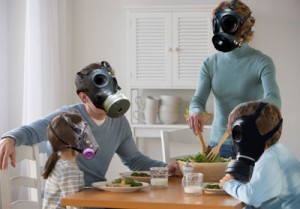4 Causes for Poor Indoor Air
According to the Environmental Protection Agency (EPA) there are four main causes for poor indoor air:
- Inadequate ventilation (less than 15 cubic feet per minute of fresh outdoor air per person
- Chemical contaminants from indoor sources such as volatile organic compounds from adhesives, carpeting, copy machines, solvents, cleaning agents, manufactured wood products, pesticides, woodstoves etc.
- Chemical contaminates from outdoor sources such as motor vehicle exhaust and plumbing vents
- Biological contaminants such a mold, bacteria, animal dander, pollen and viruses.
In addition, there are a few additional causes that may relate to long term health problems such as:
- Radon, asbestos, airborne lead or mercury vapor
- Electro-magnetic frequencies (EMF), microwaves
- Poor or inadequate temperature, humidity and/or lighting
Chemical contaminants pose a significant risk. Organic compounds are chemicals that contain carbon and are found in all living things. Volatile organic compounds or VOC’s, are organic compounds that easily become vapors or gases. VOC’s are often known for giving things their smell. VOC’s are released from burning fuel, such as gasoline, wood, coal, or natural gas. They ae also release from paint, glue, and other products used in the home or work. They are part of our daily lives for example when pumping gasoline, when working around burning fuel such as wood, when breathing some scented candles. The health effect of volatile organic compounds (VOCs) depends on:
- The characteristic of a specific VOC
- The level of the exposure
- The length of the exposure.
Long –term exposure to volatile organic compounds can cause damage to the liver, kidneys, and central nervous system and can be linked to some cancers.
Short-term exposure to VOCs can cause eye and respiratory tract irritation, headaches, dizziness, visual disorders, fatigue, loss of coordination, allergic skin reactions, nausea, and memory impairment.
VOC’s can be more problematic indoors than out. Why? Because a house or building that doesn’t have enough ventilation will not allow potential indoor pollutants to escape. This is in contrast to the air outside. Generally, the air outside naturally dilutes VOCs. Outside exposure to VOCs tend to be more common in urban settings from sources like bus or automobile exhaust.
If you suspect, chemicals in your indoor environments may be causing you, your employees or your family problems, give us call, TKEC can help.


